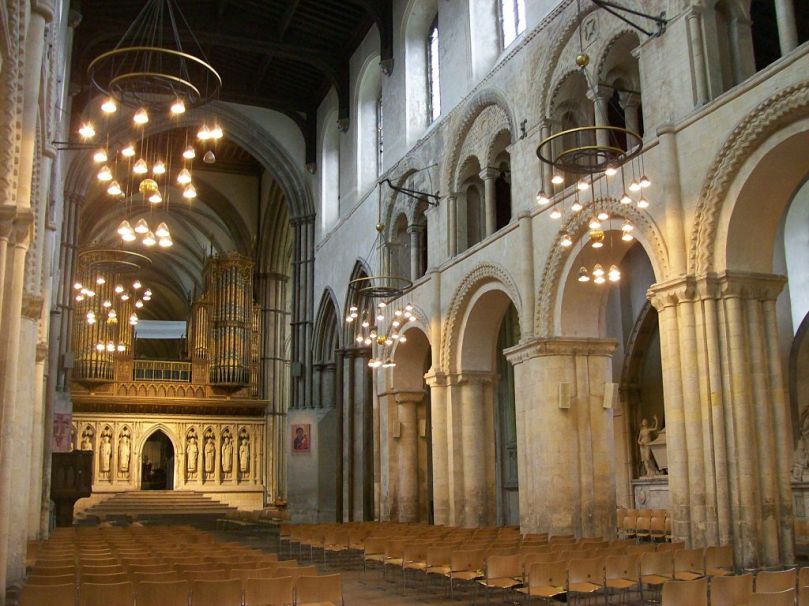The bishopric of Rochester is the second oldest in England after Canterbury. The diocese of Rochester was founded in 604 by Justus, one of the missionaries who came to Canterbury from Rome with Saint Augustine. Augustine was sent to England by Pope Gregory the Great in the late sixth century to convert the pagan English to Christianity.
King Aethelberht of Kent’s Queen was a Christian Frankish princess named Bertha and Gregory thought he would be ready to accept Christianity. Aethelberht gave the new Bishop Justus of Rochester permission to build a church on land he donated at the site of the present cathedral which initially was served by secular priests. A Saxon cathedral was built and a music school was established there. The training of the choirs was praised by the Venerable Bede in his “Ecclesiastical History of the English People”. The apse of this original church is marked and can be seen on the current cathedral floor along with sets outside delineating the line of the walls.
After Aethelberht died, the church and the Kentish kingdom were ravaged during the reign of King Aethelred I of Mercia in the 670’s. So much so that the bishop eventually gave up the diocese because of its poverty. One hundred years later, the local king and his successor gave the bishop some land and the diocese continued. After the Norman Conquest, William the Conqueror gave the cathedral and its estates to his half-brother Odo of Bayeux. Odo defrauded the resources of the diocese and the bishopric was reduced to destitution. The cathedral itself was rotted and decayed. By 1075, there were only a handful of canons living in poverty.
The first Norman bishop named Gundulf, founded a Benedictine priory at Rochester and began the construction of the present nave in 1083. The Norman Cathedral was dedicated in 1130 and King Henry I attended. The ceremony was interrupted by a fire which destroyed the entire city of Rochester and damaged the new cathedral. There were further fires in 1137 and 1179 which caused more destruction of monastic buildings, the eastern arm and the transepts. In 1180, rebuilding began in the Gothic style, starting with the quire.
In 1201, a Scottish baker named William of Perth was visiting the Cathedral when he was murdered. Stories of miracles began immediately and he was made a saint in 1256 and a shrine was built. This brought in many pilgrims and money to the cathedral allowing construction to continue. The cathedral was ravaged by King John in 1215 during the siege of Rochester Castle. Newly completed portions of the building were dedicated in 1240. The cathedral was desecrated again by the troops of Simon de Montfort in 1264. Armed knights rode into the church and hauled away some refugees, gold and silver were stolen and documents destroyed. The monastic buildings were used as stables. In 1343, Bishop Hamo de Hythe built the central tower and spire, vaulted the Transepts and re-decorated the quire. This essentially completed the cathedral.
During the reign of King Henry VIII, Rochester was one of the latest monasteries to be dissolved. In 1542, there was a new foundation of a Dean and the cathedral was re-dedicated. Oliver Cromwell’s troops caused destruction during the English Civil War. From the Restoration of the Monarchy in 1660 and throughout the eighteenth century, the building was undergoing repairs. There were major restoration projects in the mid to late nineteenth century, most notably the present tower and spire which were completed in 1904. In 2004, the Cathedral and diocese celebrated fourteen hundred years in existence with the dedication of a new fresco.


[…] View Image More Like This […]
LikeLike
My father lived in Rochester and I knew the Cathedral well. However, I spent my youth in Canterbury where we had a boy’s home, the Woodville Home. Could this have been a home financed by the Woodville family?
LikeLike
It’s possible John.
LikeLike
[…] Rochester Cathedral […]
LikeLike
I knew nothing about Rochester Cathedral, or its history, so this is fascinating. What a spectacular place, both inside and out. With its Anglo-Saxon roots, how symbolic that a fire broke out when the Cathedral was being dedicated in the presence of a Norman king.
LikeLike
HaHaHa Jo! That thought crossed my mind too about the fire.
LikeLike